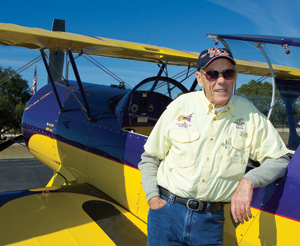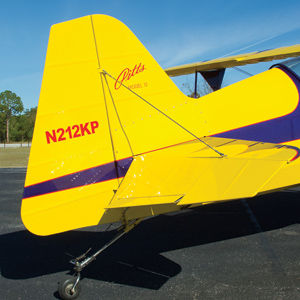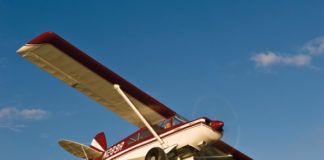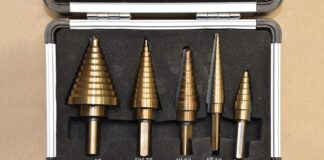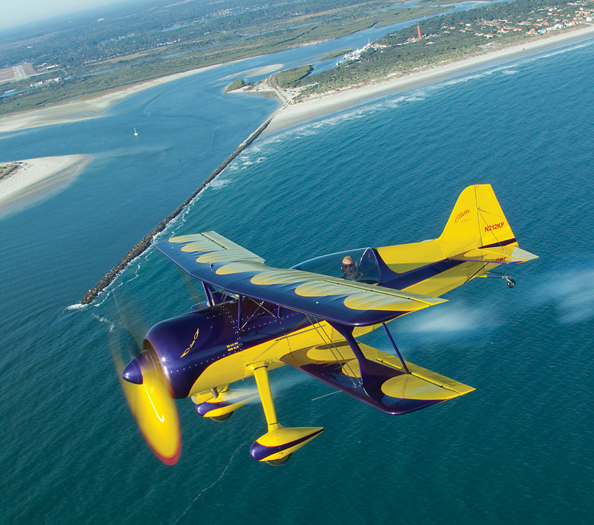
Let’s get one thing straight right off the bat. The Pitts Model 12 is not just an airplane—it’s an experience. Oh, sure, it’s a world class aerobatic mount, and it contains the other qualities needed to fit the definition of an airplane—engine, wings, fuselage, place for a human—but even just riding in it is an experience.
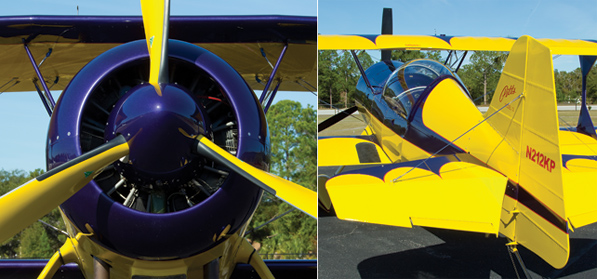
Large, powerful surfaces at the other end of the fuselage help control the snarly M14P’s prodigious power.
It begins at engine start, with the 400-horsepower Vedeneyev M14PF radial turning the big 102-inch-diameter, three-blade MT propeller the “wrong” direction. The pneumatic starter gets the engine going with the smell and the cloud of oil smoke that nowadays you see only at the larger airshows from the four-engine bombers and the airliners with the big radial engines. During taxi, that engine has a sound of suppressed meanness, of lurking yet undisguised power, a threatening loudness as the exhaust sounds regroup and echo off the pavement.
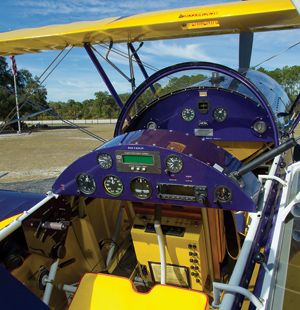
The instrument panels. VFR instrumentation is the name of the game here. Note the massive throttle in the rear.
S-turning out to the runway does little for the front-seater’s forward visibility other than waving the trees ahead side to side past that huge round nose, and then we stop briefly. Power changes during runup make the altimeter needle jump with excitement, and then it’s time for takeoff.
Hoo Boy!
Full power gets the tail up faster than you can say “Jack Robinson,” and then the nose comes up to an impossible angle as the Model 12 climbs at 75 knots, maybe 4000 feet per minute, or “only” 3200 feet per minute if you installed the 360 horsepower M14P engine. The calculator says that 4000 feet per minute is within 1.3% of 40 knots vertical speed. Haul out the trig tables, and calculate not the deck angle, but the flight-path angle. This baby moves out for sure, with 400 hp and 1850 pounds of thrust, it has a thrust-to-weight ratio approaching unity. Want a unit, a 1:1 thrust-to-weight ratio? The Beast, one of three factory-built single seaters, loaded with 20 gallons of fuel, 12 gallons of smoke oil and a 410-horsepower Barrett fuel-injected engine, achieves that. As the fluids are consumed, the ratio improves.
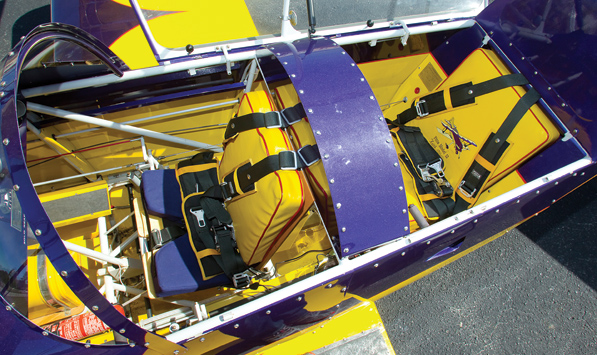
The cozy cabin is a functional area for the serious practitioner of aerobatics, or for the pilot and adventurous guest.
Model 12 History
The late Curtis Pitts completed the first three-view drawing of the Model 12 in 1993, according to Jim Kimball Enterprises. Later that year, the prototype of the Model 11 Super Stinker flew with newly designed ailerons.
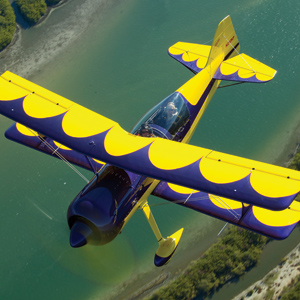
Only the top wing is swept. Note the four generously sized ailerons.
A bit later, in December of 1995, Pitts presented the Model 12 design to a group of friends at his 80th birthday party. In March of 1996, the prototype flew and test pilot Ben Morphew liked it so much that he asked the Kimballs, father Jim and son Kevin, to build him one. In 1998, the prototype was sold to a buyer in Washington state, and the unfinished Model 12 was shown at Sun ‘n Fun. The next year, serial numbers 2 and 3 flew.
Along the way, the Kimballs made a number of improvements to the original prototype. If you order just plans, they’ll let you recreate the prototype. The kit version, however, is slightly smaller, faster, lighter—and has a faster roll rate.
There are three powerplant choices. The Russian/Romanian engines come in 360- and 400-hp versions, designated M14P and M14PF. The 360-hp engine (at 34 inches of manifold pressure and 2900 rpm) has an Eastern bloc propeller flange good for 450 hp. The 400-hp engine (at 38 inches of manifold pressure and 3000 rpm) is virtually identical, but it has a bigger supercharger and a Lycoming flange rated for 400 hp. Reduction gears drive the propeller.
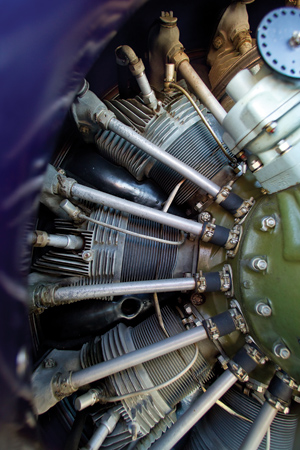
The 400-hp Vedeneyev engine inside its cowling. The disk at the top is where the prop governor cable attaches.
Engine guru Monty Barrett worked to “get more manifold pressure to the top of the pistons,” as Kevin Kimball put it. He designed new forged pistons with new rings, did some valve work that yielded a 7.8:1 compression ratio and micropolished the gears in the nose case. An Airflow Performance fuel-injection system and automotive spark plugs complete the package. The results are impressive: 410 hp, better fuel economy because there is now a mixture control, and oil consumption reduced from roughly a quart per hour to one quart per six hours.
As for propellers, the MT is the model of choice. There was an Eastern bloc version made under license, but it requires a modified governor. The old paddle-blade propellers cannot absorb the power of the engine, and the tip vortices are hard on the airframe, Kimball said. However, Whirlwind Propellers sells new blades for that hub, and is testing a three-blade prop for the M14P/Barrett engine. Hoffman propellers are also available.
Looks Are Deceiving
With that big engine and prop up front, the Model 12 looks huge, but it’s really not all that large in comparison to other biplanes. With its 22-foot wingspan, the Model 12 has only 2 feet more span than the Pitts S-2C, but 2 feet less wingspan than the 24 feet of the Steen Skybolt and Stolp Starduster Too. The Great Lakes is even bigger at just under 27 feet.
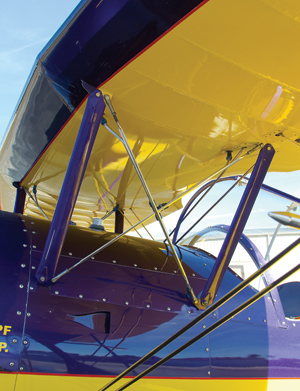
The swept upper wing is braced to a fare-thee-well, helping to make the Model 12 “strong like bull.”
Airfoils are the NACA 63A2015 on the upper wing and a symmetrical NACA 0012 on the lower. Pitts took the reflex out of the lower airfoil from the rear spar aft, making it easier to build and reducing aileron forces. He also made the rear spar taller. “He spent a few years playing around with symmetrical airfoils,” Kimball said. “I read a story that he built a set of wings for one of the famous guys, and that guy thought the wings were awesome. Curtis flew it and thought he could do better, and the guy came back and found the wings sawn up on the floor.” An important design feature is that the front wing stalls first, both upright and inverted.
The stabilizer and both wings are set at 2° positive incidence, versus 1.5° on the other Pitts models. One benefit is that the elevators run true with no trim deflection at cruise. A surprising benefit is that with the Model 12 trimmed for level flight upright, inverted flight takes very little forward pressure. In comparison, a typical S-1 or S-2, trimmed for level upright, takes 5 to 8 pounds of forward pressure inverted, and “the S-2C takes a lot more.” Kimball suspects that the square nose may have an effect with a symmetrical fuselage shape, producing lift to alleviate trim adjustments. The engine mount has no downthrust but has 2° of left thrust.
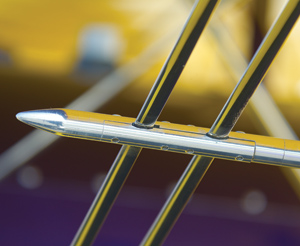
You know a work of art when you see it.
The last minor surprise is that the maximum permissible G loads are “only” +6/-4.5 (+9/-7.5 ultimate.) And even on the single-seater, they’re +8/-6. The reason is that you can do just about any maneuver within those limits.
Builder Tips
The Model 12 you see here was built by Keith Phillips, and is the 13th to fly, signed off the same day and at the same airport as numbers 14 and 15. Phillips actually took over construction of this plane after the original builder became ill, and he returned his unstarted kit to the factory. Construction was straightforward, though the center section of the upper wing was a challenge.
“Build the plane to fit you,” Phillips said, and he has made a number of changes to his. For more room in the back seat, the seat cushion is recessed. There are formation flying mirrors on each side of the canopy, and a modified tailwheel. The rudder pedals were moved forward, and the rudder cables were swaged. The flat instrument panel, now in its third iteration, is not stock. If Phillips had it to do over, he’d lower the rear rudder pedals and put a bench seat up front, “enough for two thin people.”
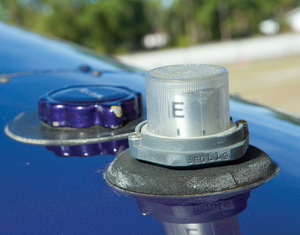
This is not a compass; it is the fuel gauge atop the forward fuselage. Train your passenger how to read it before you take off, because you’ll not see it from the back.
In the next hangar is Phillips’ first homebuilt, a Nesmith Cougar (similar to a Tailwind) being rebuilt. His Pitts S-1C is at his son’s place in Oklahoma. And a Ximango motorglider (Phillips is a dealer) completes the hangar menagerie. And the hangars have all of the tools you’d want to build a plane. “When I look at an airplane, I can tell you what kind of tools the guy had,” says Phillips, who is also an A&P/IA.
Preflight Notes
In preparation for the air-to-air photo mission, Phillips pulled the prop through, part of a clever oil management scheme devised by the Kimballs. On engine shutdown, a knob in the back cockpit shuts off a valve at the oil-tank outlet so that oil does not gravity-flow and accumulate in the lower cylinders. Then an electric scavenging pump runs for 20 to 30 seconds to move residual oil from the lower parts of the engine back into the tank. There are also oil drains on the intake tubes to the three lower cylinders, plumbed together to a drain at the bottom of the cowl. Put on a catch-can and open that drain valve. The result of all this is reduced risk of hydraulic lock, lower perceived oil consumption because the oil isn’t getting all over the hangar floor, and cleaner hangars. You still need to pull the prop through to prevent hydraulic lock, however, and there’s a microswitch so you can’t start the engine with the oil shut off.
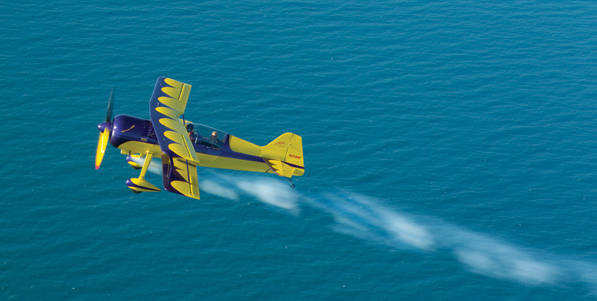
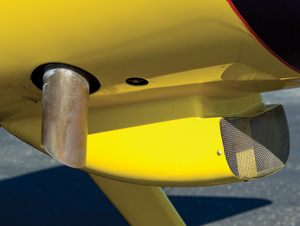
The 400-hp Vedeneyev engine breathes lots of air, both in and out. The large scoop is the oil cooler, but it also feeds the carburetor.
Clambering into the front cockpit is standard biplane clumsy, and the canopy allows tall folks only a thin seat cushion. The front cockpit has throttle and prop controls, but no power gauges. The panel has airspeed and altimeter, and in front of the windscreen, hidden from the pilot by the passenger’s head, is a novel fuel gauge that sticks out of the fuselage. With the rudder pedals way off to the sides, you feel as if you’re flying a 1930s biplane or a WW-II fighter.
Power Games
Once the Model 12 is in flight, the name of the game is power. On my first flight some months ago, we cruised out to the aerobatic area at a satisfying 140 knots indicated. If you want to fly economically, you can cruise at the same speed and fuel burn as a Grumman Tiger—130 knots true and, say, 9 gph—according to Phillips. Or should you want to, you can cruise half again as fast but at triple the fuel flow.
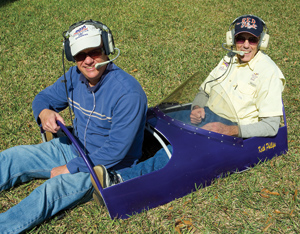
The optional open canopy replaces the stock bubble canopy and gives unlimited headroom. It flies better with the rest of the airplane.
Want to fly open cockpit? On a shelf in his hangar, Phillips has a rear-seat windshield that fits in the existing canopy mounts. The small front windshield remains in place for the front-seater. The performance cost? Twenty knots.
Power comes into the equation on loops. You don’t need anything like full power to loop the Model 12, and you can choose a variety of power settings, G forces and entry speeds. With Phillips handling the power from the back seat, I did an easy 4 G loop from level flight and 140 knots, with none of that diving for speed as in lesser airplanes.
Power is not confined to the engine, however. The ailerons have plenty of authority, and exhibit that wonderful characteristic I’ve only seen in a Pitts: giving you a feel for the roll rate as you go around. Instead of smashing in all of the ailerons to exploit the 300°-per-second roll rate, two-thirds is often enough, and you have enough authority, controllability and, more importantly, feel to modulate the roll rate to taste. That first flight, sadly, was truncated by an electrical problem.
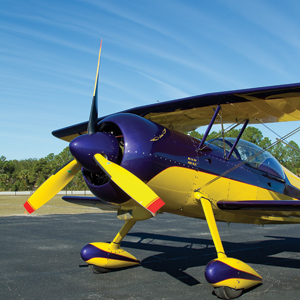
The symmetrical cowling may be the reason so little forward stick pressure is required for inverted flight.
On the way home from my second flight in the airplane, the photo mission, we didn’t have enough gas to play around, but I did one more aileron roll for good luck. Nose up, lots of left stick, and around we went, smoothly and promptly, recovering proportionately nose low with the heading absolutely unchanged. “That’s what I like about the Pitts,” Phillips said. “It goes where you point it.”
With “too many diversions,” Phillips has only 200 hours in his Model 12, mostly giving rides—short ones. But when he flies solo, and despite his 75 years, “I get pretty wild in it,” he said.
Type-Specific Training
Many airplanes have quirks, and when you get to a high-powered, high-
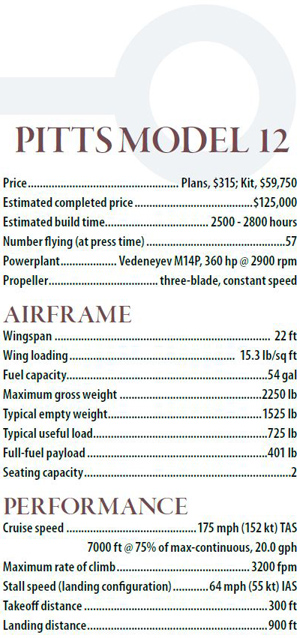
Specifications are manufacturer’s estimates and are based on the configuration of the demonstrator aircraft.
performance aerobatic airplane, a good, type-specific checkout is important. Phillips reports that if you are doing a hammerhead to the left and wait too long before pulling the power back (seconds, that is, not fractions of seconds), the enormous torque and gyroscopics of the propeller can pull you into an inverted spin, and it’s hard to recognize because the airplane is oscillating in pitch. Having done only a few inverted spins myself, I can relate that even for a pilot accustomed to upright spins, inverted spins can be as unnerving as upright spins are to the uninitiated.
Kimball reinforced this. “You can do a hammerhead in each direction given the correct inputs, but there’s training involved,” he said. “The Model 12 recovers from any of the spin regimes with standard techniques in a turn or less.”
Phillips has flown a lot of first flights in homebuilts, and he’s had the opportunity to fly the factory Model 12. He described the ground handling as “better than the little ones, not as twitchy as the S-1. It’s more like an S-2, maybe a little better. The visibility is poor; you can’t see around the big motor. Slow, with full power, the plane has a mind of its own.”
Landing can also be challenging. “The problem with the landing in the Model 12 is that the deck angle is not the stall angle,” Phillips said. “You’ve got two choices: You can touch it down at that angle and know that it’s still flying, or you can roll it on the wheels knowing that the $12,000 prop (now $17,000) is only a few inches above the runway. Or if you get a little too slow, the tail touches down first and slaps the mains down; if you’re level, the wheels hit at the same time. Otherwise, the plane rocks from wheel to wheel on the stiff gear. The big thing is the viz, but they’re all that way.”
Is It for You?
Many others besides Phillips have reported that the Model 12 is easier to fly than other Pitts biplanes. Ground handling is also better. It’s a hoot to fly for the benign maneuvers, and you don’t have to have 30 years of flying fighter jets like Phillips does. It’s worth the price of admission in the sense of taking the lessons to learn to fly it well, including those inverted spins. It’s just that much of an experience. And if you have friends to share it with, all the better!
If you’re feeling down, don’t waste your time with counseling or self-help books or men’s groups. A couple of flights per week in a Model 12 is sure to cure whatever ails you.
For more information, call 407/889-3451 or visit www.pittsmodel12.com.
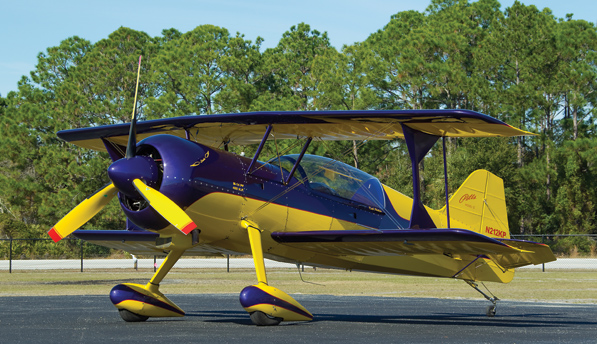
>

